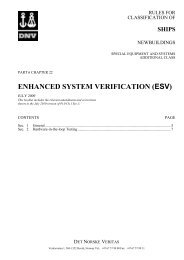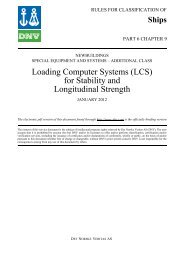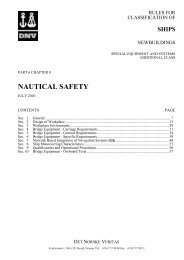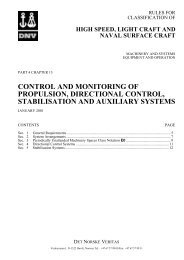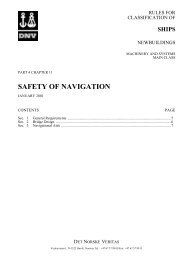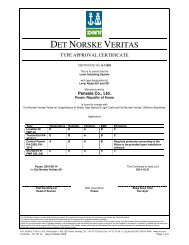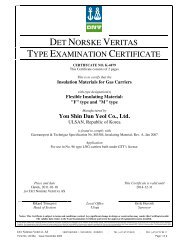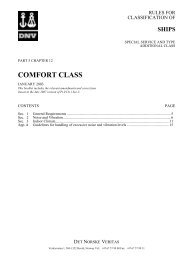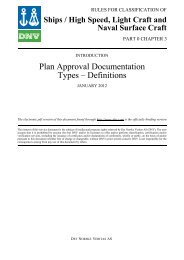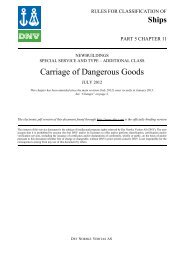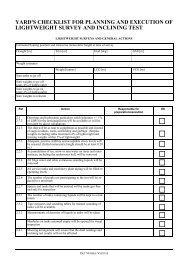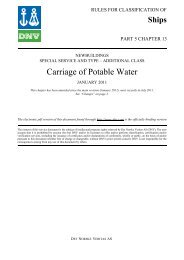Ship rules Pt.5 Ch.11 - Carriage of Dangerous Goods - DNV Exchange
Ship rules Pt.5 Ch.11 - Carriage of Dangerous Goods - DNV Exchange
Ship rules Pt.5 Ch.11 - Carriage of Dangerous Goods - DNV Exchange
You also want an ePaper? Increase the reach of your titles
YUMPU automatically turns print PDFs into web optimized ePapers that Google loves.
DET NORSKE VERITAS AS<br />
Rules for <strong>Ship</strong>s, July 2012<br />
<strong>Pt.5</strong> <strong>Ch.11</strong> Sec.1 – Page 7<br />
Class 4: Flammable solids; substances liable to spontaneous combustion; substances which, in contact<br />
with water, emit flammable gases<br />
Class 4.1: Flammable solids, self-reactive substances and desensitized explosives<br />
Class 4.2: Substances liable to spontaneous combustion<br />
Class 4.3: Substances which, in contact with water, emit flammable gases<br />
Class 5: Oxidizing substances and organic peroxides<br />
Class 5.1: Oxidizing substances<br />
Class 5.2: Organic peroxides<br />
Class 6: Toxic and infectious substances<br />
Class 6.1: Toxic substances<br />
Class 6.2: Infectious substances<br />
Class 7: Radioactive material<br />
Class 8: Corrosive substances<br />
Class 9: Miscellaneous dangerous substances and articles<br />
Class MHB: Materials hazardous only in bulk.<br />
Guidance note:<br />
Class 6.2 and Class 7 are neither covered by SOLAS Reg. II-2/19 nor this Part 5, Chapter 11 <strong>of</strong> the Rules for<br />
Classification <strong>of</strong> <strong>Ship</strong>s.<br />
---e-n-d---<strong>of</strong>---G-u-i-d-a-n-c-e---n-o-t-e---<br />
C 200 Terms<br />
201 “A-60” class divisions are smoke and fire resistant divisions formed by insulated steel bulkheads and<br />
decks complying with the SOLAS standard fire test criteria for 60 minutes exposure.<br />
They shall be insulated with non-combustible materials such that the average temperature <strong>of</strong> the unexposed side<br />
will not rise more than 140°C above the original temperature, nor will the temperature, at any one point,<br />
including any joint, rise more than 180°C above the original temperature, within 60 minutes.<br />
(SOLAS Reg. II-2/3.2.3)<br />
202 Cargo spaces are all spaces used for cargo and trunks to such spaces.<br />
(SOLAS Reg. II-2/3.8)<br />
203 Ro-ro cargo spaces are spaces not normally subdivided in any way and extending to either a substantial<br />
length or the entire length <strong>of</strong> the ship in which goods (packaged or in bulk, in or on rail or road cars, vehicles,<br />
trailers, containers, pallets, demountable tanks or in or on similar stowage units or other receptacles)can be<br />
loaded and unloaded normally in a horizontal direction.<br />
(SOLAS Reg. II-2/3.41)<br />
204 Open ro-ro spaces are ro-ro spaces either open at both ends or open at one end, and provided with<br />
adequate natural ventilation effective over their entire length through permanent openings distributed in the<br />
side plating or deckhead or from above, having a total area <strong>of</strong> at least 10% <strong>of</strong> the total area <strong>of</strong> the space sides.<br />
(SOLAS Reg. II-2/3.35)<br />
205 Closed ro-ro cargo spaces are ro-ro cargo spaces which are neither open ro-ro cargo spaces nor weather<br />
decks.<br />
(SOLAS Reg. II-2/3.12)<br />
206 Weather deck is a deck which is completely exposed to the weather from above and from at least two<br />
sides.<br />
(SOLAS Reg. II-2/3.50)<br />
207 An open deck extending into a ro-ro cargo space not having sufficient openings to be considered “open”<br />
does not fall under the definition weather deck in the context <strong>of</strong> dangerous goods.<br />
208 Hazardous area (comparable with zone 1 as defined in IEC 60092-502) is an area in which an explosive<br />
atmosphere is likely to occur in normal operation. The explosive atmosphere may exist due to gas and or dust.<br />
(IEC 60092-506, 3.1)<br />
209 Extended hazardous area (comparable with zone 2 as defined in IEC 60092-502) is an area in which an<br />
explosive atmosphere is not likely to occur in normal operation and, if it does occur, is likely to do so only<br />
infrequently and will exist for a short period only.<br />
(IEC 60092-506, 3.2)



